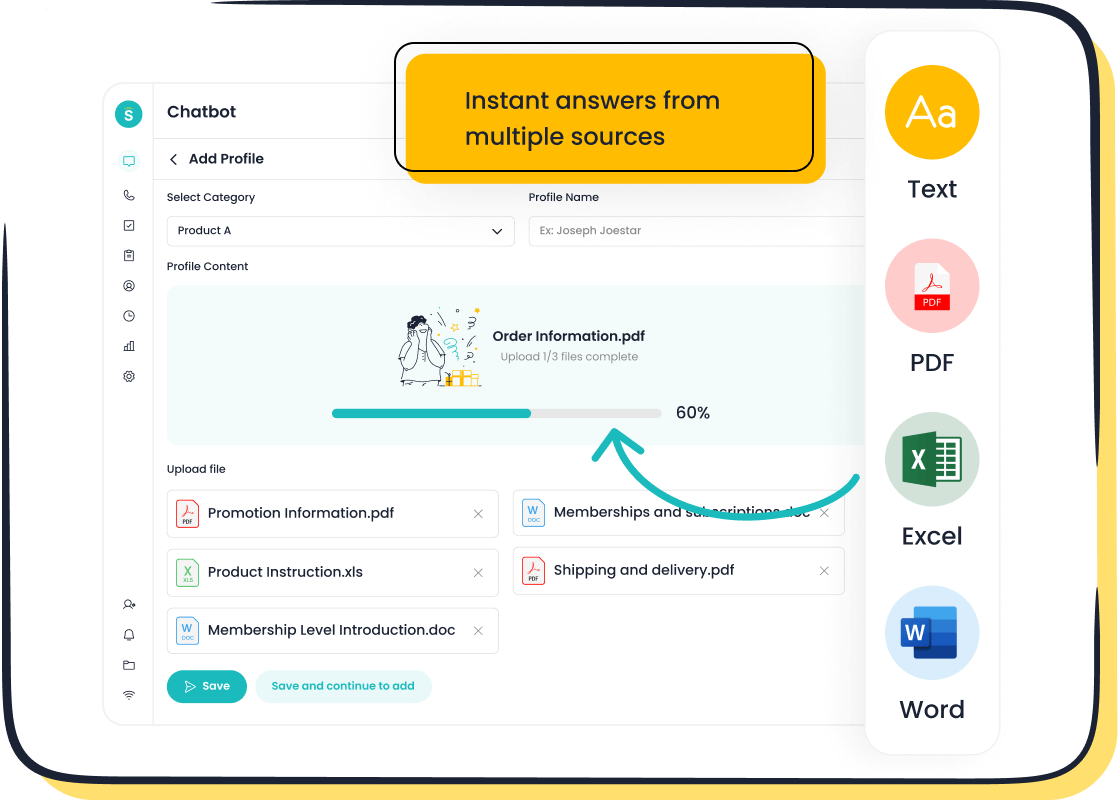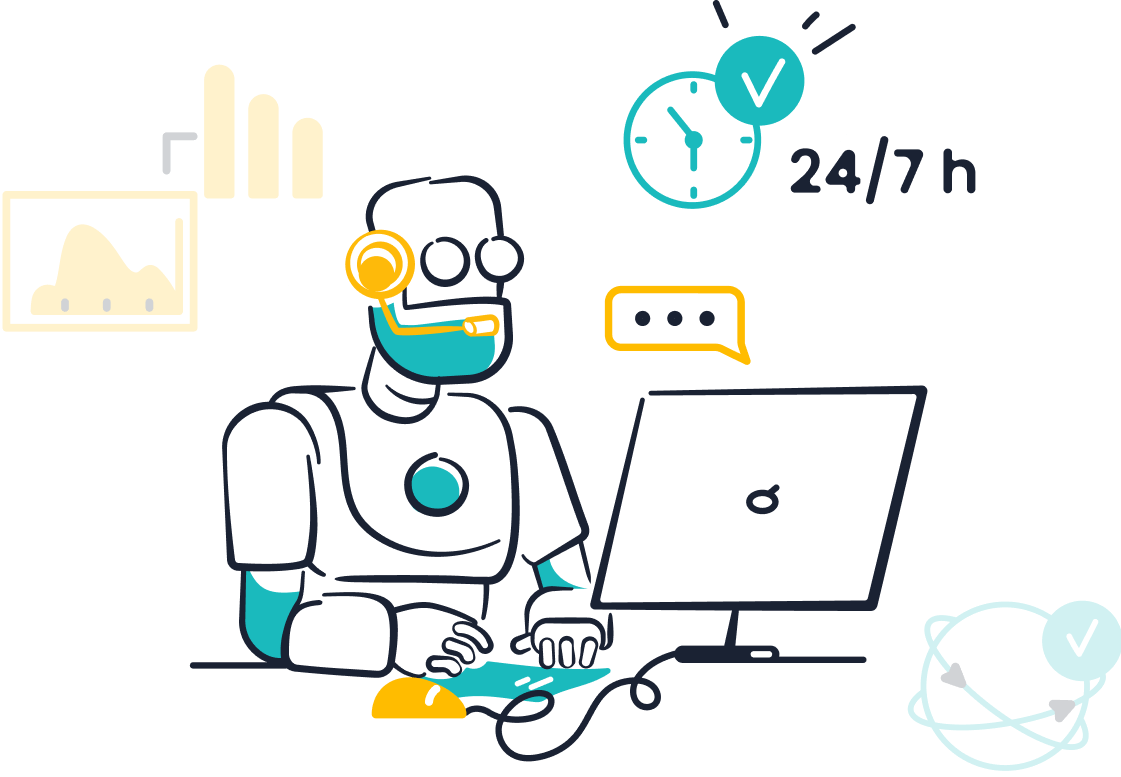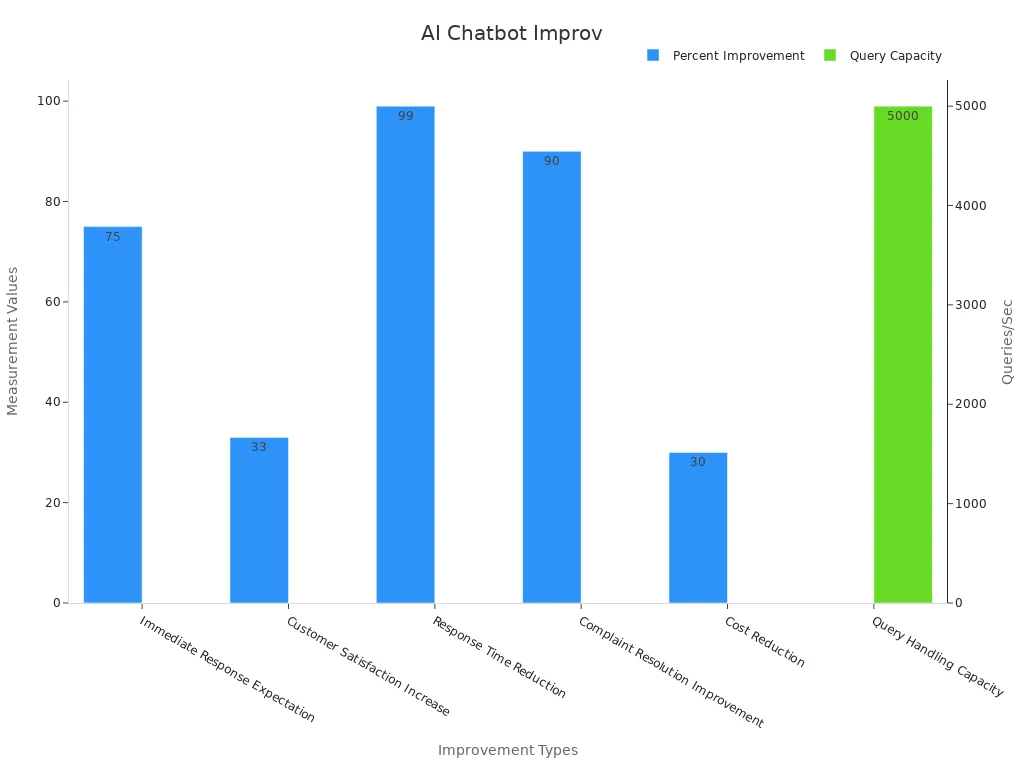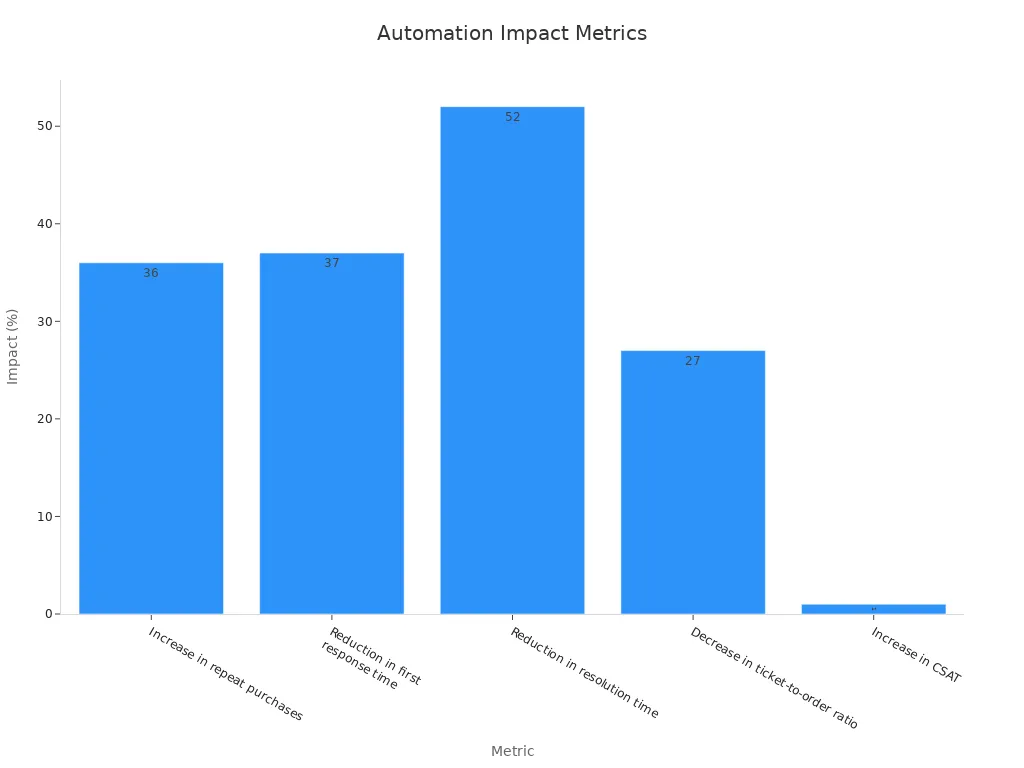How Generative AI Enhances Customer Support Efficiency

Generative AI is reshaping how businesses approach customer support. You can now automate repetitive tasks, like answering FAQs, improving efficiency and reducing costs. Companies using AI-powered virtual assistants handle 7.7% more simultaneous chats while saving an average of $4.3 million annually. This technology also ensures 24/7 availability, enabling you to scale operations seamlessly. For example, Sobot’s AI Chatbot operates around the clock, resolving regular queries autonomously. With 34% of businesses reporting revenue growth and 40% seeing better client ratings, adopting generative AI for customer support is no longer optional—it’s essential.
Understanding Generative AI for Customer Support
What Is Generative AI in Customer Support?
Generative AI in customer support refers to the use of advanced artificial intelligence to create human-like responses and automate interactions. Unlike traditional AI, which relies on predefined scripts, generative AI uses machine learning models to generate dynamic and context-aware replies. This technology enables you to provide faster, more accurate, and personalized assistance to your customers.
For example, companies like Verizon have implemented generative AI to assist their agents, resulting in a 40% increase in sales. Similarly, ING has improved response times and customer satisfaction by leveraging this technology. These real-world applications highlight how generative AI transforms customer interactions into seamless experiences.
How Generative AI Differs from Traditional AI
Generative AI stands out from traditional AI due to its adaptability, personalization, and cost-effectiveness. Here’s a quick comparison:
| Feature | Generative AI | Traditional AI |
|---|---|---|
| Cost-effectiveness | Higher upfront cost but significant long-term savings. | Lower initial costs but higher ongoing expenses. |
| Personalization | Creates individualized responses dynamically. | Relies on scripted, static replies. |
| Adaptability | Learns and evolves in real time. | Requires manual updates to adapt. |
| Customer Interaction Handoff | Provides detailed context for smooth transitions. | Often lacks seamless handoff capabilities. |
Generative AI’s ability to learn and adapt ensures that your customer support remains relevant and efficient, even as customer expectations evolve.
The Role of Generative AI in Modern Customer Service
Generative AI plays a pivotal role in modernizing customer service by automating repetitive tasks, enhancing personalization, and improving efficiency. Across industries, this technology is revolutionizing how businesses interact with their customers:
| Industry | Application Description |
|---|---|
| E-commerce | Suggests products based on browsing history and past purchases. |
| Financial Services | Monitors transactions for fraud and provides personalized financial advice. |
| Customer Service | Offers real-time response suggestions, ensuring accurate and quick resolutions. |
| Healthcare | Assists patients with scheduling and accessing medical information. |
For instance, Octopus Energy uses generative AI to handle 44% of customer inquiries, allowing agents to focus on complex issues. Similarly, Samsung leverages this technology to provide personalized product recommendations, enhancing customer satisfaction. By adopting generative AI for customer support, you can streamline operations and deliver exceptional service.
Key Benefits of Generative AI in Customer Support
Faster Query Resolution and Reduced Wait Times
Generative AI transforms how you handle customer inquiries by significantly reducing response times. This technology quickly scans and analyzes large datasets to extract relevant information, enabling clear and concise answers. For example, AI chatbots can autonomously resolve repetitive queries, allowing your team to focus on more complex issues. This automation not only improves efficiency but also ensures faster ticket resolution.
- Generative AI tools have been shown to increase productivity by an average of 66% in realistic task scenarios.
- Businesses using AI-powered solutions report a noticeable reduction in wait times, enhancing the overall customer experience.

By automating tasks like query triaging and response generation, you can manage support tickets more efficiently. Sobot’s AI Chatbot, for instance, boosts productivity by 70%, ensuring your customers receive timely and accurate assistance.
24/7 Availability and Scalability
Generative AI ensures your customer service operates round the clock, providing real-time support whenever your customers need it. Unlike human agents, AI chatbots never tire, making them ideal for handling inquiries during off-hours or peak times. This scalability allows you to manage high call volumes without compromising service quality.
| Benefit | Description | Example |
|---|---|---|
| Simultaneous Query Handling | AI can handle multiple queries at once, reducing wait times. | Walmart uses AI to respond to thousands of queries during promotions. |
| Personalized Interactions | AI provides tailored recommendations based on customer history. | Netflix uses AI to suggest troubleshooting steps based on user data. |
| 24/7 Service | AI operates continuously, providing support at any time. | A hotel booking service offers round-the-clock AI chat support for customer inquiries. |
| Scalability | AI manages high call volumes without compromising service quality. | AI can handle spikes in queries during peak times, ensuring consistent support. |
Sobot’s omnichannel solution integrates seamlessly with your existing systems, enabling you to provide uninterrupted support across multiple platforms. This ensures your customers always have access to assistance, improving customer satisfaction and loyalty.
Enhanced Personalization in Customer Interactions
Generative AI excels at delivering personalized responses tailored to individual customer needs. By analyzing customer data and behavior, this technology predicts what your customers want and adapts its responses accordingly. This creates a more human-like interaction, making your customers feel valued and understood.
- Customers experience improved satisfaction through timely and relevant responses.
- AI reduces wait times and enhances response accuracy, optimizing customer engagement.
- The technology adapts to customer preferences, offering unique experiences for each individual.
For example, Sobot’s AI Chatbot uses a knowledge base built from various sources to provide accurate, context-aware replies. Its multilingual capabilities ensure you can engage with customers in their preferred language, further enhancing efficiency and personalization. By leveraging generative AI for customer support, you can create meaningful interactions that boost customer satisfaction and loyalty.
Cost Savings and Operational Efficiency
Generative AI has become a game-changer in reducing costs and improving operational efficiency in customer service. By automating tasks that consume significant time, such as query triaging and repetitive responses, you can allocate resources more effectively. This shift allows your team to focus on high-value activities, ultimately driving better results.
- Companies using generative AI tools report cost savings of up to 25%.
- In the financial sector, automating manual tasks reduces workloads by over 40%.
- Generative AI can impact up to 90% of working hours in banking, enabling employees to prioritize strategic initiatives.
For customer support, this means fewer resources spent on routine inquiries and more attention given to complex customer needs. AI chatbots, like Sobot’s, operate 24/7, handling up to 70% of repetitive queries autonomously. This not only reduces the need for additional agents but also ensures real-time support for your customers. According to a recent study, businesses deploying generative AI tools see productivity increases of up to 20%, with novice workers improving by 35%.
The operational efficiency gained from generative AI extends beyond cost savings. It enhances the customer experience by reducing wait times and delivering personalized responses. For example, Sobot’s omnichannel solution integrates seamlessly with platforms like WhatsApp and SMS, ensuring consistent service across all channels. This unified approach improves customer satisfaction while optimizing your team’s workload.
How Sobot’s Chatbot Boosts Productivity by 70%
Sobot’s AI Chatbot stands out as a powerful tool for enhancing efficiency in customer service. Designed to automate customer interactions, it handles regular queries autonomously, allowing your agents to focus on more complex issues. This human-machine collaboration significantly boosts productivity.
The chatbot’s key features include:
- 24/7 Availability: It operates round the clock, ensuring your customers receive real-time support anytime.
- Multilingual Capabilities: It communicates in multiple languages, catering to a global audience.
- No Coding Required: Its point-and-click interface makes setup easy, even for non-technical users.
- Omnichannel Support: It integrates with various platforms, providing seamless customer service across channels.
By automating tasks that typically take up 60% to 70% of employees’ time, Sobot’s chatbot reduces workloads and improves efficiency. Businesses using this solution report a 70% increase in productivity and a 50% reduction in service costs. Additionally, its ability to deliver personalized responses enhances customer satisfaction and loyalty. For instance, OPPO achieved an 83% chatbot resolution rate and a 94% positive feedback rate after implementing Sobot’s solutions.
With Sobot’s AI Chatbot, you can streamline operations, cut costs, and deliver exceptional customer service. This makes it an essential tool for businesses aiming to stay competitive in today’s fast-paced market.
Practical Applications of Generative AI in Customer Support

Generative AI has revolutionized customer support by introducing innovative tools and solutions that enhance efficiency and improve customer satisfaction. Below are some practical applications of this transformative technology.
AI-Powered Chatbots for Instant Responses
AI-powered chatbots have become a cornerstone of modern customer service. These chatbots provide real-time assistance by instantly responding to customer queries, ensuring faster resolutions and improved satisfaction. Unlike traditional systems, generative AI chatbots can understand context, generate personalized responses, and handle complex interactions.
For example, Sobot’s AI Chatbot operates 24/7, autonomously resolving up to 70% of repetitive queries. Its multilingual capabilities allow businesses to cater to a global audience, ensuring seamless communication. This not only reduces wait times but also enhances personalisation in customer interactions.
Here’s a snapshot of measurable improvements achieved through AI chatbots:
| Improvement Type | Measurement |
|---|---|
| Immediate Response Expectation | 75% of customers expect immediate responses from chatbots. |
| Customer Satisfaction Increase | AI-driven customer support can boost customer satisfaction by 33%. |
| Response Time Reduction | AI chatbots can decrease response times by 99%. |
| Query Handling Capacity | AI chatbots can handle up to 5,000 customer queries per second. |
| Complaint Resolution Improvement | 90% of businesses report measurable improvements in complaint resolution times with AI. |
| Cost Reduction | AI-powered chatbots reduce customer service costs by up to 30%. |

By leveraging conversational AI, you can provide hyper-personalized customer service while scaling operations efficiently.
Automating Email and Ticket Management
Generative AI streamlines email and ticket management processes, transforming how businesses handle customer inquiries. Traditional methods often involve manual sorting and categorization, which can be time-consuming and prone to errors. AI automates these tasks, ensuring faster response times and improved accuracy.
With tools like Sobot’s ticketing system, you can automate workflows, manage SLAs, and allocate tickets to the right agents. This reduces the time-to-resolution from several minutes to just a few seconds. Additionally, real-time analytics optimize workflows, enabling your team to focus on high-priority tasks.
Key benefits of automating tasks like email and ticket management include:
- Improved efficiency and scale by reducing manual effort.
- Enhanced customer satisfaction through faster resolutions.
- Increased first-contact resolution rates, boosting overall service quality.
Generative AI ensures that your customer support automation processes are seamless, allowing you to deliver exceptional service consistently.
Multilingual Support for Global Customers
In today’s globalized world, providing support in multiple languages is essential for building trust and loyalty. Generative AI excels in language understanding and generation, enabling businesses to offer personalized customer experiences in their customers’ native languages.
Sobot’s AI Chatbot, for instance, supports multilingual interactions, ensuring that customers from different regions receive accurate and context-aware responses. This fosters trust and enhances customer satisfaction, especially for businesses with a diverse customer base.
Benefits of AI-powered multilingual support include:
- Higher customer satisfaction rates due to improved communication.
- Faster response times and more efficient operations.
- Enhanced personalisation, creating meaningful connections with customers.
By integrating multilingual capabilities into your customer service strategy, you can cater to a broader audience and strengthen your global presence.
Sentiment Analysis for Proactive Engagement
Sentiment analysis powered by generative AI allows you to understand your customers' emotions and intentions during interactions. By analyzing text, tone, and context, this technology identifies whether a customer feels satisfied, frustrated, or confused. This insight enables you to take proactive steps to improve their experience.
For example, generative AI can detect early signs of dissatisfaction, helping you intervene before a customer decides to leave. Businesses using sentiment analysis have reported significant benefits:
- A reduction in average handling time by 15-20%.
- An increase in customer satisfaction scores by up to 30%.
| Statistic Description | Value |
|---|---|
| Reduction in average handling time | 15-20% |
| Increase in customer satisfaction | Up to 30% |
Imagine a scenario where a customer expresses frustration over a delayed delivery. Sentiment analysis can flag this interaction, allowing your team to prioritize the issue and offer a resolution. This proactive approach not only resolves problems faster but also strengthens customer loyalty.
Sobot’s AI-driven tools enhance this process by integrating sentiment analysis into its omnichannel solution. The system monitors customer interactions across platforms, providing real-time insights to your agents. This ensures that every customer receives timely and personalized support, improving their overall experience.
Sobot’s Omnichannel Solution for Seamless Customer Experiences
Sobot’s omnichannel solution transforms how you manage customer service by unifying all communication channels into a single platform. Whether your customers reach out via email, social media, or live chat, this solution ensures a consistent and seamless experience.
The integration of AI-driven insights plays a crucial role in this strategy. By analyzing customer data from multiple touchpoints, Sobot’s solution helps you understand their needs and preferences. This allows you to deliver personalized interactions that resonate with your audience. For instance:
- AI identifies patterns in customer behavior, enabling you to tailor your responses.
- Real-time insights improve the relevance of your interactions.
- Data integration eliminates fragmented communication, ensuring smooth transitions between channels.
| Strategy | Result |
|---|---|
| Integration of WhatsApp | Enhanced customer engagement and revenue growth |
| AI-driven insights | Improved customer satisfaction and efficiency |
Sobot’s customer-first approach ensures that your team has the tools needed to provide exceptional service. The platform’s ability to integrate with popular systems like WhatsApp and SMS further enhances its versatility. By automating tasks such as query triaging and response generation, Sobot’s solution reduces agent workloads and improves efficiency.
For example, OPPO leveraged Sobot’s omnichannel solution to integrate its global customer channels. This eliminated data silos and improved service delivery. The result? An 83% chatbot resolution rate and a 94% positive feedback score. These outcomes highlight how Sobot’s solution drives both operational efficiency and customer satisfaction.
By adopting Sobot’s omnichannel solution, you can streamline your customer support operations and deliver a seamless experience across all platforms. This approach not only enhances efficiency but also builds stronger relationships with your customers.
Implementing Generative AI in Customer Support
Setting Clear Goals and Objectives
Before implementing generative AI, you need to define clear and measurable goals. These goals should align with the SMART criteria: Specific, Measurable, Achievable, Relevant, and Time-bound. For example, you might aim to reduce ticket resolution time by 30% within six months or improve customer satisfaction scores by 20% in a year.
Organizations often use Objectives and Key Results (OKRs) to set ambitious targets. Key Performance Indicators (KPIs) help track progress effectively. Metrics like cost savings, reduced system downtime, and faster incident response times provide tangible benchmarks for success.
Tip: Start small by focusing on one or two key areas, such as improving first-contact resolution rates or automating repetitive tasks. This approach ensures manageable implementation and measurable outcomes.
Choosing the Right Generative AI Tools
Selecting the right tools is critical for successful implementation. You should evaluate AI solutions based on their ability to meet your business needs. Consider factors like cost optimization, operational efficiency, and customer satisfaction impact.
| Criteria | Description |
|---|---|
| Competitive Differentiation | Assess how the tool sets your business apart from competitors. |
| Cost Optimization | Determine if the solution offers long-term savings. |
| Operational Efficiency | Measure how well the tool reduces manual tasks and streamlines workflows. |
| First Contact Resolution Rate | Analyze the percentage of issues resolved on the first interaction. |
| Customer Satisfaction Score (CSAT) | Evaluate customer satisfaction levels post-interaction. |
For instance, Sobot’s AI Chatbot excels in operational efficiency by autonomously resolving up to 70% of repetitive queries. Its multilingual capabilities and omnichannel support make it a versatile choice for businesses aiming to enhance customer service across platforms.
Training AI Models with Relevant Data
Training your AI models with high-quality, relevant data ensures accurate and effective performance. Begin by collecting data from customer interactions, such as chat logs, emails, and feedback forms. Use this data to build a robust knowledge base that reflects your customers’ needs and preferences.
Generative AI thrives on diverse datasets. For example, Sobot’s AI Chatbot uses data from articles, PDFs, and text snippets to provide instant, context-aware replies. Regularly updating your AI with new data keeps it aligned with evolving customer expectations.
Note: Monitor your AI’s performance and refine its training data periodically. This ensures continuous improvement and prevents outdated responses.
Monitoring and Optimizing AI Performance
To ensure your generative AI tools perform effectively, you need to monitor key metrics and optimize them regularly. Tracking performance helps you identify areas for improvement and maintain high service quality. Metrics like accuracy, response time, and customer satisfaction provide valuable insights into how well your AI is meeting user expectations.
| Metric | Description |
|---|---|
| Active Users | Tracks how many users interact with the AI over a specific period. |
| Session Duration | Measures the average time users spend engaging with the AI, reflecting its usefulness. |
| Accuracy/Error Rate | Indicates how often the AI provides correct responses, ensuring reliability. |
| Customer Satisfaction | Gauges user happiness through surveys and feedback. |
| Time Saved | Quantifies how much time the AI saves users, enhancing productivity. |
| Cost Reduction | Measures the impact of AI on lowering operational costs. |
For example, Sobot’s AI Chatbot uses real-time analytics to monitor these metrics. This allows you to refine its knowledge base and improve response accuracy. Regular updates ensure the chatbot adapts to changing customer needs, maintaining its effectiveness over time. By focusing on these metrics, you can optimize your AI tools to deliver consistent, high-quality support.
Tip: Use customer feedback to identify gaps in your AI’s performance. This helps you make targeted improvements and build trust with your users.
Integrating Sobot’s Chatbot with Existing Systems
Integrating Sobot’s Chatbot with your existing systems enhances efficiency and streamlines operations. The chatbot connects seamlessly with platforms like Salesforce, Shopify, and WhatsApp, creating a unified workspace for your team. This integration eliminates data silos and ensures smooth communication across channels.
| Company | Integration Details | Results |
|---|---|---|
| H&M | Uses AI chatbots for customer inquiries, returns, and product suggestions. | Improved customer satisfaction. |
| KFC | Leverages AI to analyze purchase history for tailored menu suggestions. | Enhanced shopping experience. |
| OPPO | Achieved an 83% chatbot resolution rate with a 57% boost in repurchase rates. | Increased customer retention. |
For instance, OPPO integrated Sobot’s Chatbot with its global customer service platform. This allowed agents to access customer data instantly, reducing response times and improving service quality. The chatbot resolved 83% of queries autonomously, freeing agents to handle complex issues. These results demonstrate how integration can transform your customer support strategy.
Note: Start by integrating the chatbot with one system, then expand to others. This phased approach minimizes disruptions and ensures a smooth transition.
Challenges and Considerations When Implementing Generative AI
Ensuring Data Privacy and Security
When implementing generative AI in customer support, safeguarding data privacy and security is crucial. Regulations like GDPR and CCPA require you to secure personal data and obtain explicit consent. Non-compliance can lead to hefty fines, making adherence to these laws essential.
Generative AI models can inadvertently generate sensitive information if not trained with privacy-preserving algorithms. To mitigate risks, you should:
- Limit data retention to minimize exposure.
- Use anonymization techniques to protect identities.
- Restrict training on proprietary data to avoid leaks.
- Secure generated outputs with encryption and access controls.
For example, Sobot’s AI Chatbot ensures compliance by integrating advanced security measures, protecting both customer data and generated responses. By prioritizing data governance, you can build trust and maintain regulatory compliance.
Balancing AI Automation with Human Interaction
Striking the right balance between automation and human interaction is key to improving customer satisfaction. While generative AI excels at handling repetitive tasks, it often lacks the empathy needed for complex issues. Companies that combine AI with human agents see better results. AI manages initial queries, while agents provide compassionate resolutions for more nuanced problems.
For instance, a French e-commerce company adopted this hybrid model. AI handled routine inquiries, and human agents addressed emotional concerns. This approach increased customer satisfaction and efficiency. Studies show that 64% of consumers feel the human element is often overlooked, and 75% prefer human support when AI tools fall short.
Sobot’s omnichannel solution supports this balance by seamlessly transitioning between AI and human agents. This ensures your customers receive both speed and empathy, fostering loyalty and trust.
Avoiding Over-Automation in Customer Support
Over-automation can harm customer experiences if not implemented carefully. While automation reduces response times and operational costs, excessive reliance on AI may lead to impersonal interactions. A study from Nature highlights that poorly executed automation can negatively impact service quality and customer engagement.
| Metric | Impact |
|---|---|
| Increase in repeat purchases | 36% |
| Reduction in first response time | 37% |
| Reduction in resolution time | 52% |
| Decrease in ticket-to-order ratio | 27% |
| Increase in CSAT | 1% |

To avoid over-automation, you should monitor customer feedback and adjust your AI tools accordingly. Sobot’s AI Chatbot, for example, allows you to customize workflows, ensuring a balance between automation and personalized service. This approach enhances efficiency without compromising the human touch.
Addressing Bias in AI-Generated Responses
Bias in AI-generated responses can negatively impact customer trust and satisfaction. Generative AI learns from data, which means it can unintentionally adopt biases present in the training material. These biases may lead to unfair or inaccurate responses, especially when dealing with diverse customer groups. You must actively address this issue to ensure your AI tools provide fair and inclusive support.
Start by training your AI models with diverse and representative datasets. This reduces the likelihood of biased outputs. Regularly audit your AI’s responses to identify patterns that may indicate bias. For example, if your chatbot consistently misunderstands queries from non-native speakers, it may require adjustments to its language processing capabilities. Tools like Sobot’s AI Chatbot include multilingual support, which helps minimize language-related biases and ensures accurate communication with global customers.
Transparency is another critical factor. Inform your customers when they are interacting with AI and provide an option to escalate to a human agent. This builds trust and allows for better handling of sensitive issues. Monitoring customer feedback also helps you identify and address potential biases. By taking these steps, you can create an AI system that delivers fair and unbiased support.
Managing Customer Expectations with AI
Managing customer expectations is essential when implementing AI in customer support. Customers often expect instant and accurate responses, especially when interacting with AI-powered tools. To meet these expectations, you need to set clear service benchmarks and monitor performance metrics.
Focus on metrics like customer satisfaction (CSAT) to evaluate how well your AI meets customer needs. Separate reporting for 'bot first response time' and 'human first response time' provides a clearer picture of your system’s efficiency. For instance, Sobot’s omnichannel solution tracks these metrics, helping you optimize both AI and human interactions. Analyzing CSAT ratings for AI interactions also reveals areas for improvement, ensuring your support remains effective.
Educating your customers about AI’s capabilities and limitations is equally important. Let them know what tasks your AI can handle and when a human agent will step in. This transparency prevents frustration and builds trust. For example, Sobot’s AI Chatbot seamlessly transitions complex queries to human agents, ensuring a smooth customer experience. By managing expectations effectively, you can enhance satisfaction and foster loyalty.
Real-World Examples of Generative AI in Action

Case Study: OPPO’s Success with Sobot’s Chatbot
OPPO, a global leader in smart devices, faced challenges during peak shopping seasons. High inquiry volumes overwhelmed their support team, leading to delays and customer dissatisfaction. By implementing Sobot’s AI Chatbot, OPPO transformed its customer service operations. The chatbot handled repetitive queries autonomously, allowing human agents to focus on complex issues. This collaboration improved efficiency and reduced response times.
Sobot also optimized OPPO’s knowledge base, automating 90% of its maintenance. This ensured accurate and timely responses to customer inquiries. The results were remarkable. OPPO achieved an 83% chatbot resolution rate and a 94% positive feedback score. Additionally, the company saw a 57% increase in repurchase rates, highlighting the chatbot’s impact on customer loyalty. This case demonstrates how generative AI can enhance productivity and satisfaction in customer support.
AI-Driven Personalization in the Retail Industry
Generative AI has revolutionized personalization in retail, enabling businesses to connect with customers on a deeper level. By analyzing customer data, AI tailors product recommendations and marketing strategies to individual preferences. This approach delivers several benefits:
- Enhanced Customer Experience: Personalized suggestions make shopping more enjoyable and fulfilling.
- Increased Sales and Conversion Rates: Tailored recommendations encourage purchases, boosting revenue.
- Higher Customer Retention: Customers feel valued, fostering loyalty and repeat business.
- Optimized Marketing Strategies: Targeted campaigns improve engagement and maximize ROI.
- Improved Inventory Management: AI predicts trends, ensuring stock availability and reducing waste.
For example, a retailer using AI might suggest a winter coat to a customer browsing cold-weather gear. This targeted approach not only increases the likelihood of a sale but also strengthens the customer relationship. Sobot’s omnichannel solution supports such personalization by integrating customer data across platforms, ensuring consistent and meaningful interactions.
Multilingual Support in Global Tech Companies
Generative AI has made multilingual support more accessible and accurate, helping global companies serve diverse audiences. AI-powered tools translate and transcribe customer interactions with high precision, ensuring clear communication. Metrics validate these improvements:
| Metric Type | Description |
|---|---|
| BLEU Score | Measures translation quality |
| Word Error Rate (WER) | Quantifies transcription accuracy |
| Human-evaluated Metrics | Captures qualities like coherence and factual correctness |
Sobot’s AI Chatbot excels in multilingual support, enabling you to engage customers in their preferred language. This capability builds trust and enhances satisfaction, especially in regions with diverse linguistic needs. By adopting generative AI, you can break language barriers and deliver exceptional service worldwide.
AI-Assisted Ticket Resolution in SaaS Businesses
AI-assisted ticket resolution has become a game-changer for SaaS businesses. Managing customer inquiries efficiently is critical in this fast-paced industry. Generative AI simplifies ticket resolution by automating repetitive tasks, categorizing tickets, and providing accurate solutions. This technology ensures faster responses, reduces workloads, and improves customer satisfaction.
For example, SaaS companies often deal with high volumes of support tickets. These tickets may include issues like login problems, subscription queries, or feature requests. Generative AI analyzes these tickets, identifies patterns, and suggests solutions instantly. This reduces the time agents spend on manual sorting and allows them to focus on complex issues. Studies show that AI can reduce ticket resolution time by up to 40%, significantly enhancing operational efficiency.
Sobot’s ticketing system takes AI-assisted ticket resolution to the next level. It automates workflows, manages SLAs, and assigns tickets to the right agents. The system uses real-time analytics to prioritize urgent issues, ensuring no ticket gets overlooked. For instance, if a customer reports a billing error, the AI flags it as high priority and routes it to the appropriate team. This streamlined process improves first-contact resolution rates and boosts customer satisfaction.
Tip: Use AI tools like Sobot’s ticketing system to handle repetitive queries. This approach saves time and ensures consistent service quality.
Generative AI also enhances collaboration within your team. By integrating with platforms like Salesforce or Shopify, Sobot’s solution provides a unified workspace. Agents can access customer data instantly, making it easier to resolve tickets accurately. This integration eliminates data silos and ensures seamless communication across departments.
Incorporating AI-assisted ticket resolution into your SaaS business strategy helps you stay competitive. It improves efficiency, reduces costs, and ensures your customers receive timely and accurate support. Explore tools like Sobot’s ticketing system to transform your customer service operations today.
Generative AI for customer support is revolutionizing how you interact with customers. It enhances efficiency, reduces costs, and improves satisfaction. Sobot’s AI Chatbot and Omnichannel solutions demonstrate this transformation. For example, OPPO achieved an 83% chatbot resolution rate and a 94% positive feedback score using Sobot’s tools. By adopting generative AI, you can meet growing customer expectations and stay competitive. Explore Sobot’s solutions today to elevate your customer support strategy.
Tip: Visit Sobot’s website to learn more about their AI-powered tools.
FAQ
What is generative AI, and how does it improve customer support?
Generative AI uses advanced machine learning to create human-like responses. It automates repetitive tasks, reduces wait times, and personalizes interactions. For example, Sobot’s AI Chatbot resolves up to 70% of queries autonomously, improving efficiency and customer satisfaction.
Can generative AI handle multilingual customer support?
Yes, generative AI excels at multilingual support. Sobot’s AI Chatbot communicates in multiple languages, ensuring accurate and context-aware responses. This feature helps businesses engage global customers effectively, enhancing satisfaction and loyalty.
How does Sobot’s omnichannel solution benefit customer service?
Sobot’s omnichannel solution unifies communication channels like email, WhatsApp, and live chat. It ensures seamless transitions between platforms, reducing data silos. This integration improves efficiency and provides consistent, high-quality support across all customer touchpoints.
Is generative AI cost-effective for businesses?
Generative AI reduces operational costs by automating repetitive tasks. Sobot’s AI Chatbot saves up to 50% on agent expenses while boosting productivity by 70%. These savings make it a cost-effective solution for businesses of all sizes.
How can I start using generative AI for customer support?
Begin by defining your goals and selecting the right tools. Sobot offers AI-powered solutions like chatbots and ticketing systems. These tools integrate easily with existing platforms, enabling you to enhance efficiency and deliver exceptional customer service.
Tip: Explore Sobot’s website to learn more about their generative AI solutions for customer support.
See Also
Enhancing Efficiency With AI-Driven Customer Service Tools
Transforming Support Through AI Customer Service Agents
Increasing Customer Satisfaction In E-commerce With Chatbots
